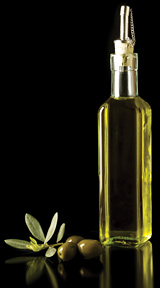Choosing "Good" Oils: Three Rules
While choosing what to eat is getting more and more complicated, there are three simple rules to help you choose the oils that will help, not hurt:
- Avoid oils that are high in trans fats. Stay away from food or cooking oils that contain trans fats. Avoiding trans fats should be easier now that they must be listed on labels, but beware: "0 trans fats" means there could be up to .5 g in each serving. Since the American Heart Association suggests you get less than 1 percent of your calories from trans fats, for a 2,000 calorie diet that would be about 2 grams (18 calories). So, after four servings of a zero-trans-fat food, you could theoretically hit your limit.
- Limit saturated fat in all forms. Since our body makes saturated fats, we don't necessarily need to eat them. Most of these fats are found in meat and whole-fat dairy products like milk, cheese, yogurt, and ice cream; however, some oils, like coconut, are particularly high in saturated fat. Saturated fats have been linked to elevated LDL and cardiovascular disease.
- Stick to the serving size. For cooking oil, one serving is a tablespoon - not a sweeping flourish or a "glug-glug-glug" into the pan. In that tablespoon are 14 grams of fat, or 126 calories. That's as many calories from fat as a large slice of pizza, or to put it another way, 15 minutes of moderate running (more or less, depending on your weight; but you get the picture, right?).
For adults, the Food and Drug Administration recommends between 5 (about 1 ½ tablespoons or 21 g) and 7 teaspoons (just over 2 tablespoons or roughly 28 g) of oil a day depending on age and gender. This includes oil from all sources (food, cooking oil, and condiments). For fat in general, the American Heart Association suggests you should get no more than 25-35 percent of your total calories from all types of fat. For a 2,000 calorie diet, that breaks down to less than 16 g of saturated fat, less than 2 g of trans fat, and between 50 and 70 g of total fat each day.
What Are Some Good Oil Choices?
Compared to less healthy fats/oils, mono- or polyunsaturated fats can be considered "good" oils. These are from plants, nuts, or seeds and can contribute to a healthy diet in a variety of ways.
 Omega-3 and Omega-6 fatty acids. The current stars of the "good" oil world are "omega-3" and "omega-6" fatty acids. These polyunsaturated fatty acids are so named because they have a double bond after the third carbon and the sixth carbon, respectively. Because our body can't synthesize them from other constituents, we need to get them from our diet.
Omega-3 and Omega-6 fatty acids. The current stars of the "good" oil world are "omega-3" and "omega-6" fatty acids. These polyunsaturated fatty acids are so named because they have a double bond after the third carbon and the sixth carbon, respectively. Because our body can't synthesize them from other constituents, we need to get them from our diet.
Omega-3 fatty acids: The most widely studied omega-3 fatty acid is alpha-linolenic acid (ALA), which can be made into two longer fatty acids called EPA and DHA. These are the omega 3s you'll get from fish and fish oil supplements. Increased omega-3 intake is solidly associated with lower cardiovascular disease risk and a lowered risk of heart attack/sudden death in people with coronary heart disease. Additionally, research suggests that omega-3 supplementation maybe helpful for treating type 2 diabetes, as well as joint tenderness in people with rheumatoid arthritis. Omega-3 fatty acids are also being studied as an adjunctive treatment for Alzheimer's disease, dementia, depression, bipolar disorder, and schizophrenia. They can be found in flaxseeds (ground or oil), walnuts (whole nuts or oil), and canola oil. Fish like herring, salmon, and oysters have high levels of EPA and DHA.
Omega-6 fatty acids: Omega-6 fatty acid is also called linoleic acid (LA). Safflower oil, pine nuts, pecans, and sesame oil are good sources of LA. These fatty acids have been associated with lowering the risk of coronary heart disease in a number of studies. Other research demonstrates that omega-6s can lower total and LDL cholesterol in some people.
Research continues to find tantalizing ways in which these fats complement treatment of chronic conditions. For example, in a recent study published in the American Journal of Clinical Nutrition, obese, postmenopausal women diagnosed with type 2 diabetes were asked to take a safflower supplement containing 6.4 g of LA per day. The researchers reported that this supplement was associated with a reduction of torso fat, lowered blood sugar markers, and increased muscle tissue after 16 weeks.
Olive oil. Olive oil is another good oil. It has a solid research pedigree and a great taste. Olive oil is made up of monounsaturated fats, which have been linked to reducing LDL cholesterol, as well as a number of other health-promoting compounds like iron, phytosterols (cholesterol-like compounds found in plants), vitamin K, and polyphenols (antioxidant compounds found in fruits, vegetables, and some nuts). All types of olive oil contain the same amount of fat, so it doesn't matter if you prefer virgin or extra-virgin; go with what tastes best to you.

